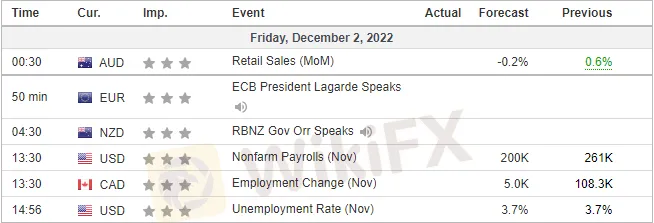Mohicans markets:MHM Today News
Abstract:On Thursday (December 1), expectations of the Federal Reserve slowing down interest rate hikes rose, and the dollar index fell below 105, a new low since August, closing 1.07% lower at 104.74. Non US currencies rose sharply.
![第一篇[英语]](https://d126a7rrmtfkku.cloudfront.net/fb_article/2022-12-02/638055900210815445/FB638055900210815445_310402.jpg-article598)

December 2, 2022 - Fundamentals Reminder
☆ 10:40 European Central Bank President Lagarde attended the meeting.
☆ At 21:30, the United States announced the unemployment rate in November and the non-agricultural employment population after the quarterly adjustment in November. The data may affect the Federal Reserve's policy decisions.
☆ At 02:00 the next day, the United States announced the total number of oil wells in the week from December 2.
☆ At 04:30 the next day, the American CFTC released its weekly position report.
Market Overview
Review of global market trend

cThe US dollar fell 2% against the Japanese dollar within the first day. The euro rose above 1.05 against the US dollar, and the pound rose above 2% against the US dollar at the highest level. It once rose above three levels, 1.21 to 1.23. The yield on the 10-year US Treasury note fell 10 basis points to 3.50%. The US 30-year bond yield fell 10 basis points to 3.633%.
The sharp decline in US dollar and US bond yields boosted gold and silver prices. The spot gold stood at 1800 US dollars/ounce, the first time since August 15. It was more than 30 US dollars higher than the daily low, and ended 1.97% higher at 1803.04 US dollars/ounce. Spot silver closed 2.51% higher at $22.75/oz.
On the eve of the OPEC+meeting, crude oil surged by more than 3% during the day, giving back some of the gains in the late trading, and WTI crude oil closed 1.13% higher at 81.39 USD/barrel; Brent crude oil closed 0.39% higher at US $87/barrel.
Cautiousness spread on the eve of non-agricultural activities. The US stock market ended mixed, with the Dow down 0.56%, the Nasdaq up 0.13%, and the S&P 500 down 0.09%. Gold stocks and WSB concept stocks were among the top gainers, while aviation stocks and popular Chinese probability stocks mostly retreated. Xiaopeng Automobile closed down about 8%, Weilai Automobile closed down about 5%, and Ideal Automobile closed down about 3%. The fear index VIX fell below 20 for the first time since August.
Most European stocks ended higher, with Germany's DAX30 index up 0.64%, Britain's FTSE 100 index down 0.17%, France's CAC40 index up 0.23%, Europe's Stoxx 50 index up 0.48%, Spain's IBEX35 index up 0.55%, and Italy's FTSE MIB index up 0.24%.
Market Focus
1. Atlanta Fed GDPNow model: Cut Q4 growth forecast to 2.8% from 4.3%.
2. Volcano Mauna Loa in Hawaii continues to erupt, sending lava flows closer to the road.
3. The U.S. Senate passed a bill to prevent rail workers from striking (without the provision of paid leave) and sent it to Biden for his signature.
4. The U.S. Department of Energy is seeking to suspend or delay authorizing the sale of the Strategic Petroleum Reserve for the 2024-27 fiscal year as it seeks to replenish its combat reserve, a move that could affect 147 million barrels of crude oil.
5. US media: The Biden administration is considering ending its monkeypox public health emergency declaration.
6. G7 officials said Russia's oil price ceiling would be adjusted based on a number of factors, including market prices, which could rise or fall.
7. Fed dove Charles Evans steps down as president of the Chicago Fed in January. Austan Goolsbee, a former Obama economic adviser, will take over and become an FOMC committee member.
8. 【Fed official speaks】 Barr: Officials generally agreed that policy was now in a restrictive range and that a 50 basis point rate hike in December was justified; Mr. Williams: Interest rates need to be sufficiently above inflation that where they end up depends on the data; Bowman: With interest rates close to a sufficient limit, it makes sense to slow the pace of rate increases, with the end rate higher than expected in September.
9. 【Data】Treasury 10Y is close to breaking below 3.5%; The U.S. core PCE price index rose 0.2% in October, the smallest increase since July. Euro zone unemployment hit a record low of 6.5% in October; The fear index, the VIX, fell below 20 for the first time since August; Spot gold traded above $1,800 for the first time since August.
Geopolitical Situation
Conflict Situation:
1. Russian troops are attacking Ukrainian positions in the direction of Uglidar.
2. Air raid sirens were issued across Ukraine, Ukrainian officials said on December 1.
3. Senior aide to Ukrainian President Volodymyr Zelensky: So far, between 10,000 and 13,000 Ukrainian soldiers have been killed in the conflict with Russia.
4. Ukrainian media: Intelligence shows that the Russian army is withdrawing its troops from the villages of Mykhailivka, Poloi and Inzhenerne in the Zaporoje region.
5. Ukrainian lawmakers say more than 40 percent of the country's rail infrastructure has been damaged since Russia launched its special military operation against Ukraine, but that authorities are continuing to repair the damage.
Energy Situation:
1. Diplomats: EU close to $60 Russian oil price cap deal Poland is still pushing for a lower price cap and talks will continue today.
2. Gazprom: We produced 376.9 billion cubic meters of gas in January-November. Global gas demand fell by 55 billion cubic meters in 11 months, of which about 50 billion cubic meters came from European Union countries.
MHMarkets - Institutional Perspective
1. Goldman Sachs:Bonds appear to be the asset manager of choice again.
2. SOCIETE GENERALE:The S&P 500 is on track to hit 3800 by the end of 2023.
3. MUFG:Markets “liked Powell's speech.” They had expected him to maintain the hawkish tone of this month's meeting, but he did not make himself more hawkish.
Statement | Disclaimer
Disclaimer: The information contained in this material is for general consultation only. It does not take into account your investment objectives, financial situation or special needs. We have made every effort to ensure the accuracy of the information as of the date of publication. MHMarkets makes no warranty or representation on this material. The examples in this material are for illustrative purposes only. To the extent permitted by law, MHMarkets and its employees shall not be liable for any loss or damage arising from any information provided or omitted in this material in any way (including negligence). The characteristics of MHMarkets' products, including applicable fees and charges, are outlined in the product disclosure statement provided on MHMarkets' website. Derivatives may be risky; The loss may exceed your initial payment. MHMarkets recommends that you seek independent advice.
MohicansMarkets, (abbreviation: MHMarkets or MHM, Chinese name: Maihui), Australian Financial Services License No. 001296777.

Read more

Mohicans markets:MHM European Market
Spot gold weakened slightly during the Asian session on Thursday (April 6), hitting a two-day low of $2007.89 per ounce and now trading near $2014.15. A series of weak economic data has fueled fears of an impending recession in the US, giving safe-haven support to the dollar. And some dollar shorts took profits, and gold bulls also took profits ahead of Good Friday and the non-farm payrolls data, putting pressure on gold prices.

Mohicans markets:MHM Today News
On Wednesday, as the less-than-expected March "ADP" data and non-manufacturing PMI data fueled market concerns about an economic slowdown and spurred bets that the Federal Reserve could slow interest rate hikes. Spot gold continued to brush a new high since March last year, which was the highest intraday to $2032.13 per ounce, and then retracted most of the day's gains, finally closing up 0.01% at $2020.82 per ounce; spot silver hovered around $25 during the day, finally closing down 0.21% at $2

Mohicans markets:MHM European Market
Spot gold oscillated slightly lower during the Asian session on Tuesday (April 4) and is currently trading around $1980.13 per ounce. The dollar index rebounded mildly after a big drop overnight, putting pressure on gold prices. However, this week will see the non-farm payrolls report, there is no important economic data out on Tuesday, and the market wait-and-see sentiment is getting stronger.

Mohicans markets :MHM Today News
On Monday, in OPEC + members unexpectedly cut production reignited market concerns about long-term inflation and sparked uncertainty about the Fed's response, the dollar index once up to the 103 mark, and then on a "vertical roller coaster", giving back all the gains of the day and once lost 102 mark, finally closed down 0.53% at 102.04; U.S. 10-year Treasury yields rose and then fell, as data showed that the U.S. economy continues to slow, it fell sharply in the U.S. session, and once to a low
WikiFX Broker
Latest News
Ringgit hits five-year high against US dollar in holiday trade
Forex vs. Stocks vs. Futures: Which Market Fits Your Wallet?
Commodities: Gold Targets $5,000 as Central Banks Buying Spree Meet Geopolitical Shocks
Is Finalto Legit or a Scam? 5 Key Questions Answered (2025)
Spring Rally in Chinese Equities Signals Potential Lift for AUS and NZD
Transatlantic Rift: Visa Wars and Tech Tariffs Threaten EUR/USD
JPY Alert: Bond Yields Hit 29-Year High as Market Challenges BOJ
US Banking Giants Add $600B in Value as Deregulation Widens Gap with Europe
Markets Wrap: Gold and Equities Surge to Records as Holiday Liquidity Thinness Rattles Speculative A
Stop Chasing Headlines: The Truth About "News Trading" for Beginners
Rate Calc


